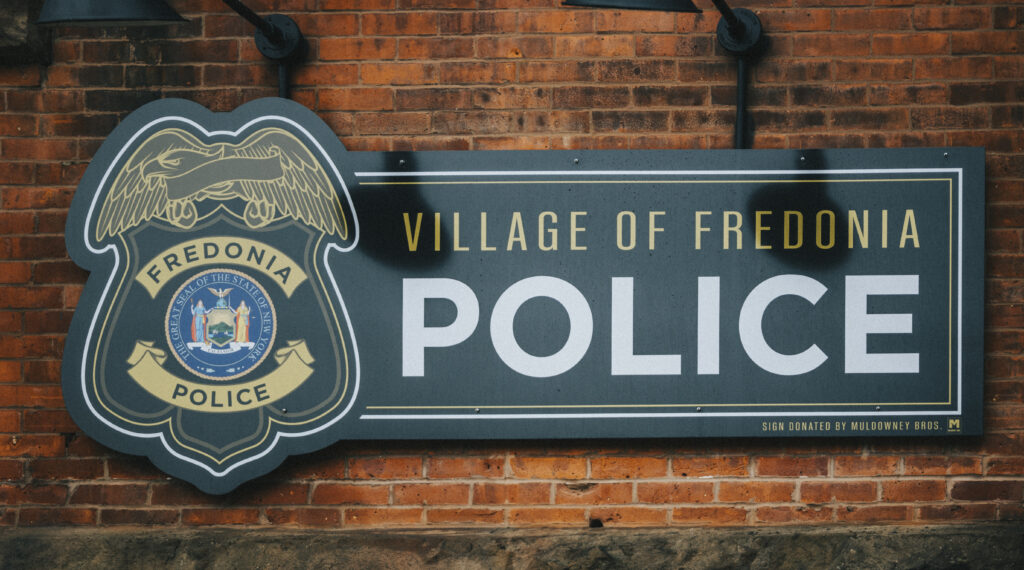Student files federal civil rights case against village police

CASEY HUBER
Special to The Leader
A SUNY Fredonia student and his mother have filed a federal civil rights case against two Village of Fredonia police officers as a result of a January incident. The student was arrested while police were investigating an incident in which the student says he was the victim — not the perpetrator.
The names of the mother and student involved in the case have been kept anonymous. The Leader agreed to provide anonymity in exchange for interviews and access to related body cam footage.
The Leader reached out to Fredonia police for a comment, but they have not responded. The Leader has acquired the police records, lawsuit documents and police body camera footage of the incident discussed.
The Lawsuit
On March 14, 2022, the civil rights violation-based lawsuit was filed against two members of the Fredonia Police Department (FPD).
The plaintiffs are the alleged victim and his mother, and the accused are Sergeant Michael Napierala and Police Chief David Price. The lawsuit charges both Napierala and Price as officials, meaning that they are being sued as police officers, not as individuals.
In the lawsuit, the claimants write that the violations include “The lack of discretion, violation of civil rights, VOIL (freedom of information law) violations, dishonesty with intent to cause harm, procedural violations, blackmail, abuse of power, bullying, dereliction of duty, defamation of character and harassment.”
As restitution, the lawsuit asks for “punitive damages in the amount of $7,500 … for the distress the situation has caused. Repeated court visits, missed classes, emotional duress and embarrassment.”
Filed in the United States District Court for the Western District of New York, the basis for jurisdiction is under article 42 section 1983 of the United States Constitution, stating a person can sue state or local officials for the “deprivation of any rights, privileges or immunities secured by the Constitution and [federal laws],” according to the lawsuit.
The Incident
The following is a general reconstruction of the video taken by the son on his cellphone camera as well as body camera footage from police officers.
The victim alleges he was assaulted on Jan. 29, 2022, around midnight outside of Old Main Inn, a bar in downtown Fredonia.
According to both the mother and the alleged victim’s testimonial, the latter of which was recorded by police body cameras, the victim was assaulted by two people inside Old Main Inn. He was then pushed outside and assaulted again by two different people.
According to Officer Zachary Hand’s supplemental police report, police were called to the scene of an assault “in the area of Bella Maria’s Pizza on Water Street.”
According to the report, police “spoke to the doorman of Muldoon’s Bar located at 26 Water Street. The doorman stated that one of the subjects involved in the fight was a Black male wearing a blue hoodie and that male went to Canadaway Street.”
While walking home after the assault, the alleged victim was stopped by FPD Officer Dylan Robinson on Canadaway Street. Hand’s report wrote that Robinson “observed a male matching the description given to officers and stopped to speak to him.”
The alleged victim was with three other people who were walking him home. They tried to explain to the officer that they did not know what happened but they were trying to get him home safely. The body camera footage shows Robinson largely ignoring the three and focusing on the alleged victim.
The alleged victim did not fully match the suspect description given to police officers except for one attribute — he is a Black male. He was wearing a black sweatshirt without a hood — not a blue hoodie.
The alleged victim pointed out this discrepancy in the physical suspect description to Robinson in his body cam footage, to which Robinson replied “Why are you giving me shit?” and held the alleged victim at Canadaway until additional officers arrived.
At no point was the alleged victim asked if he was the victim by Robinson; he maintained that the alleged victim matched the description of the suspect and treated him as such.
Five minutes into the initial interaction, the alleged victim said, “If I’m not under arrest, I can do whatever the fuck I want, so I’m walking home.”
Robinson replied “No, no, you’re not going anywhere,” and approached the victim.
The victim stopped, then dialed his mother.
The next line of Hand’s report says “[Robinson] then requested additional officers to Canadaway Street.”
Five minutes and 30 seconds after the initial stop, as recorded in the body camera footage, Sergeant Napierala and Officer Hand arrived.
According to Hand’s body camera footage, the alleged victim said that the police stopped him because he was a Black male. He said, “Oh my god, how many Black males do you know? Can I go home?” to which Hand replied “No.”
After the alleged victim and Hand continued to disagree, Hand told the alleged victim to relax. The alleged victim said, “I’m either walking away or you’re fucking arresting me, you can’t stop me here. If you’re gonna question me you have to fucking arrest me, so I’m going to walk away.”
Napieralla then said, “Alright, you’re under arrest.”
The alleged victim replied, “For what?”
Napieralla said, “For disorderly conduct.”
The alleged victim was then taken to the police station where he was held and questioned repeatedly, without being Mirandized or given access to a lawyer, until his release at 1:20 a.m.

Why did the arrest occur? And was it justified?
In Napieralla’s supplemental police report, it states that he said, “‘Okay then we’ll keep you under arrest for disorderly conduct for swearing.’ [Alleged victim] was highly intoxicated and uncooperative.” Here, Napieralla claims the reason the victim was arrested was for swearing.
However, later in the same document, Napieralla wrote, “I told [the mother] he was yelling, ‘Fucking arrest me’ several times, and that’s why he’s being arrested.”
Was the alleged victim arrested for saying “arrest me” or for swearing? Or both?
Are either of these two criteria sufficient to arrest someone, regardless of whether they apparently fit a suspect profile?
The New York Court of Appeals, which is the highest court in New York State, unanimously ruled in 2015 that swearing at an officer is not illegal. A story in The Gothamist, a New York City website that is part of New York Public Radio, headlined a story on it as Court Affirms It’s Completely Legal To Swear Loudly At Police.
The 2015 story described a case where a man, Richard Gonzalez, was searched because he had sworn at officers in a subway. They found a knife on him and arrested him under New York’s gravity-knife law.
The incident occured in 2011 and was decided by the highest state court four years later.
The memorandum states, “Here, however, there is no record support for the motion court’s determination that defendant’s rant against the police officers constituted the crime of disorderly conduct,” according to law.justia.com.
So, if the alleged victim was arrested for swearing, the arrest would be illegal.
What if he was arrested for stating “arrest me”?
There appears to be no legal precedent in either direction. Officers are generally given discretion in their policing to make arrests if necessary.
The question is, was this arrest necessary?
(See the editorial “Why did Fredonia police not consider Black male a victim?” for The Leader’s take on this.)
But was the arrest conducted correctly?
After analyzing the police body camera footage, it is apparent the alleged victim asked for a lawyer at least twice, and no acknowledgement of that request was given by officers.
Furthermore, the alleged victim was interrogated by Napieralla and Hand on two different occasions at the police station without him being given the opportunity to get a lawyer or him being read his Miranda rights.
Conferring Miranda rights means that the officer says that you have the right to remain silent, that anything you say can be used against you in a court of law, that you have the right to a lawyer during questioning and if you cannot afford a lawyer one will be appointed to you, according to Nolo, a website for legal advice.
However, also according to Nolo, “Police officers don’t have to provide the Miranda warning to people they arrest. They’re free to arrest you, put you in the back of a patrol car and take you to the station for booking without once mentioning your rights.”
Miranda rights are only relevant when a suspect is in custody and subject to interrogation.
If the alleged victim’s Miranda rights should’ve been read, then what the victim said during interrogation cannot be used by the prosecution in a court of law.
However, it should be of note that the alleged victim was never asked if he was the victim of the assault. The body camera footage appears to show that the alleged victim was considered a suspect from the beginning of his interaction with police. Only later did police realize that the alleged victim was the victim, and subsequently interrogated him, presumably to confirm that he was the victim.
Given that the alleged victim was not read his rights and still interrogated, there could potentially be a legal issue beyond a civil rights violation.
The alleged victim has not had his appearance in court yet.
